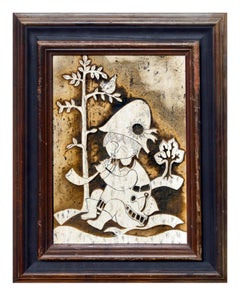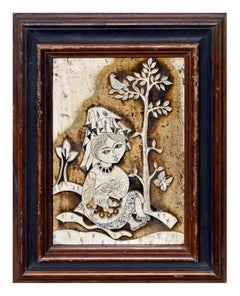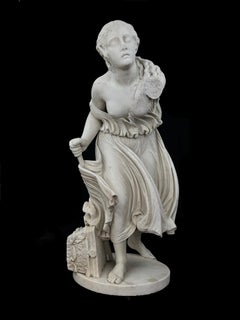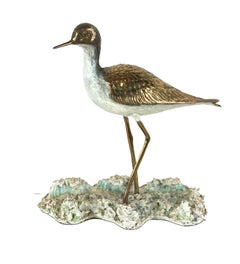Want more images or videos?
Request additional images or videos from the seller
1 of 13
R. HoboldEarly 20th Century Bronze Figure Sculpture, Shepherd Girl with Staff Statuelate 19th c
late 19th c
$880List Price
About the Item
- Creator:R. Hobold (German)
- Creation Year:late 19th c
- Dimensions:Height: 9 in (22.86 cm)Width: 3.5 in (8.89 cm)Depth: 3.5 in (8.89 cm)
- Medium:
- Movement & Style:
- Period:
- Condition:Small hole in bronze base to the right of the left foot. Left hand has a tiny hole, appears to be missing an element that the figure was holding.
- Gallery Location:Soquel, CA
- Reference Number:Seller: JT-75061stDibs: LU5429449942
About the Seller
5.0
Platinum Seller
Premium sellers with a 4.7+ rating and 24-hour response times
Established in 1986
1stDibs seller since 2014
3,004 sales on 1stDibs
Authenticity Guarantee
In the unlikely event there’s an issue with an item’s authenticity, contact us within 1 year for a full refund. DetailsMoney-Back Guarantee
If your item is not as described, is damaged in transit, or does not arrive, contact us within 7 days for a full refund. Details24-Hour Cancellation
You have a 24-hour grace period in which to reconsider your purchase, with no questions asked.Vetted Professional Sellers
Our world-class sellers must adhere to strict standards for service and quality, maintaining the integrity of our listings.Price-Match Guarantee
If you find that a seller listed the same item for a lower price elsewhere, we’ll match it.Trusted Global Delivery
Our best-in-class carrier network provides specialized shipping options worldwide, including custom delivery.You May Also Like
Emile Louis Picault (1833-1915), 'Le Penseur'
By Émile Louis Picault
Located in Berlin, DE
Emile Louis Picault (1833-1915), 'Le Penseur', patinated bronze mounted on a marble base, H 30 - 33 cm (bronze - total)
A fantastic quality Bronze of
Emile Louis Picault
Signed o...
Category
Late 19th Century Jugendstil Figurative Sculptures
Materials
Bronze
$3,910
H 13 in W 4.73 in D 4.73 in
Hebe Par Drouot Edouard Drouot (French, 1859-1945)
Located in Berlin, DE
Bronze, beautifully cast, patinated. Above a fluted round base, the figure of the Greek goddess of youth. Hébé is depicted here rising in a tight-fitting robe before an eagle, the sy...
Category
Early 20th Century Jugendstil Figurative Sculptures
Materials
Bronze
$6,137
H 30.71 in W 8.67 in D 8.67 in
Antique bronze nude gladiator/ swordsman - Signed "Rudolf Marcuse" + "Gladenbeck
By Rudolf Marcuse
Located in Berlin, DE
Antique bronze nude gladiator/ swordsman - Signed "Rudolf Marcuse" + "Gladenbeck Berlin"
Dimensions:
Sculpture: 16.5 cm high
Base: 6.5 cm high
To...
Category
Early 20th Century Jugendstil Figurative Sculptures
Materials
Bronze
Rudolf MarcuseAntique bronze nude gladiator/ swordsman - Signed "Rudolf Marcuse" + "Gladenbeck, 1913
$5,114
H 9.45 in W 8.27 in D 2.76 in
Eugene Marioton - Bronze Statue
By Eugene Marioton
Located in Berlin, DE
Eugène Marioton
französisch, 1854 - 1933
Muscular Nude Male Bronze Eugene Marioton - Bronze Statue, um 1900
A handsome and very fit partially draped young nude male with rippling mu...
Category
19th Century Jugendstil Figurative Sculptures
Materials
Bronze
French Art Nouveau bronze JOAQUÍN ANGLÉS CAÑÉ
Located in Berlin, DE
JOAQUÍN ANGLÉS CAÑÉ (Tortosa, 1859 - Paris, 1911).
Joaquin Anglès Cañé
(born 1859 Tortosa - c. 1925)
Idyll. Original title:
Bronze, dark brown patinated. Sign.
'Idyll', a bronze sta...
Category
20th Century Jugendstil Figurative Sculptures
Materials
Bronze
$4,151
H 18.9 in W 5.12 in D 4.73 in
Raoul Fançois Larche Patinated bronze figure of a woman
Located in Berlin, DE
FRANCOIS-RAOUL LARCHE 1860 SAINT-ANDRÉ-DE-CUBZAC - 1912 PARIS
Signed on the base with "RAOUL LARCHE," foundry mark "SIOT DECAUVILLE PARIS FONDEUR," and number "R 276."
Total height...
Category
Early 1900s Jugendstil Figurative Sculptures
Materials
Bronze
$3,850
H 16.93 in W 4.34 in D 4.34 in
Eugène Laurent (1832-1898), The Beachcomber
Located in Berlin, DE
Eugène Laurent (1832-1898),
The Beachcomber
Inscribed "E. Laurent" on the base plate in the cast.
H 63 cm
Eugène Laurent studied at the École des Beaux-Arts in Paris and was awa...
Category
Early 19th Century Jugendstil Figurative Sculptures
Materials
Bronze
$6,076
H 24.81 in W 7.09 in D 7.09 in
Beautiful late 19th-century bronze sculpture by Mathurin Moreau
By Mathurin Moreau
Located in Berlin, DE
Beautiful late 19th-century bronze sculpture by Mathurin Moreau
"YOUNG WOMAN ON A ROCK" BY MATHURIN MOREAU (1822-1912)
Young girl with a broken jug,
Bronze circa 1880/1890, France
...
Category
Late 19th Century Jugendstil Figurative Sculptures
Materials
Bronze
$5,114
H 20.87 in W 6.7 in D 6.7 in
Eugene Laurent (French, 1832-1898) Diana the Huntress
Located in Berlin, DE
LAURENT, Eugene, (French, 1832-1898): Diana the Huntress, bronze,
64 cm high,
signed, resting on a black marble base, in an antique dress with her hunting dog.
Patinated bronze....
Category
Late 19th Century Jugendstil Figurative Sculptures
Materials
Bronze
$4,392
H 25.2 in W 9.45 in D 7.09 in
Seifert, Victor Heinrich. 1870 Wien - 1953 Berlin “Young athlete with slingshot”
Located in Berlin, DE
Seifert, Victor Heinrich. 1870 Vienna - 1953 Berlin
"Young Athlete with Slingshot" "David"
Large bronze, dark patinated, signed: Prof. V.H. Seifert
Height: 71.5 cm, approx. 85 cm h...
Category
Early 20th Century Jugendstil Figurative Sculptures
Materials
Bronze
$5,114
H 33.08 in W 7.88 in D 7.88 in
More From This Seller
View AllMid Century Carved Marble Flute Player
By Rodney Winfield
Located in Soquel, CA
Mid Century carved marble flute player by Rodney Marshall Winfield (American, b. 1925). Presented in a rustic wooden frame. Unsigned. Image size: 14"H x 10"W. Framed: 20"H x 16"W. Wear to frame and age wear to marble.
A painter in acrylic, designer in stain glass and silver, sculptor and long-time teacher, Rodney Winfield has had a diverse career. He was born in New York City. As a young man, he was artistically inclined and composed music, drew and painted, danced, wrote poetry and created sculpture. Choosing to focus on art, he enrolled in Cooper Union School in New York City.
From 1953 to 1970, he was a stain-glass designer for Emil Frei...
Category
1960s Folk Art Figurative Paintings
Materials
Marble
$320 Sale Price
20% Off
Mid Century Carved Figurative Girl and Kitten
By Rodney Winfield
Located in Soquel, CA
Mid century carved marble figurative girl and kitten by Rodney Marshall Winfield (American, b. 1925). Presented in rustic wood frame. Bio on verso. Image, 14"H x 10"W.
Rodney studied at Cooper Union School in New York and worked as a designer at the Emil Frei...
Category
1960s Folk Art More Art
Materials
Marble
$460 Sale Price
20% Off
NYDIA, THE BLIND FLOWER GIRL OF POMPEII Marble Sculpture 1856-1870
Located in Soquel, CA
Randolph John Rogers (American, 1825 - 1892) Randolph Rogers' Nydia, the Blind Flower Girl of Pompeii debuted in 1856 to critical and public acclaim, solidifying Rogers’ position as a pre-eminent American sculptor and it remains one of the artist’s most celebrated works today. The subject of Nydia is drawn from Edward Bulwer-Lytton's The Last Days of Pompeii 1834. After touring the ruins of the ancient city in 1833, and inspired by the stories of blinding volcanic ash, he composed the tale of Nydia, a slave who led her master, Glaucus, to safety. Rogers depicts Nydia at the moment that she and Glaucus have become separated in their perilous journey through the rubble and Nydia seeks familiarity in the surrounding chaos, her distress evident in her pained expression. The grace of the sculpture is at odds with the turmoil portrayed; a toppled Corinthian capital lies at her feet and obstructs her next step, indicated by the tilt of her back foot and grip on her walking stick. Examples of this model can be found in major American collections, including The Metropolitan Museum of Art, the Art Institute of Chicago, the Detroit Institute of Arts, the Los Angeles County Museum of Art, and the Museum of Fine Arts, Boston.
Literature, Millard F Rogers, Jr. Randolph Rogers, American Sculptor in Rome. University of Massachusetts Press, 1971, American Figurative Sculpture in the Museum of Fine Arts Boston. Museum of Fine Arts, Boston, 1986. Joyce K Schiller. "Nydia, A Forgotten Icon of the Nineteenth Century." Bulletin of the Detroit Institute of Arts,
Born in Waterloo, New York, Randolph John Rogers became an expatriate* sculptor of idealized figures, portraits, and commemorative works in Neo-Classical* and Realist* styles. He worked in clay, plaster, marble and bronze, and lived both in Italy and the United States. He made 167 examples of Nydia in two sizes (varies depending on base height) 36" and 54'.
Rogers was raised in Ann Arbor, Michigan, and as a young man did woodcuts* for the local newspaper, The Michigan Argus, and also worked as a baker's assistant and a dry goods clerk. In 1847, he moved to New York City, where he hoped to find work as an engraver*, but failing to do so, worked in a dry goods store owned by John Steward...
Category
1850s Italian School Figurative Sculptures
Materials
Marble
$12,000 Sale Price
20% Off
Bronze Sculpture -- California Shorebird in the Waves
By Doris Warner
Located in Soquel, CA
Modern Bronze and Ceramic Sculpture of Silt Sandpiper in Waves.
Beautiful bronze sculpture of iconic Californian Silt Sandpiper in the waves by Doris Ann Warner (American, 1925-2010...
Category
1970s American Realist Figurative Sculptures
Materials
Bronze
Burled Maple Sculpture Nude Woman with Arms Over Head and Stone
Located in Soquel, CA
Burled Maple Sculpture Nude Woman with Arms Over Head
Beautiful burled walnut sculpture of a nude woman. The woman stands with her arms stretched over her head. Behind her a dark st...
Category
Mid-20th Century Post-War Figurative Sculptures
Materials
Stone
$3,087 Sale Price
35% Off
Vintage Abstract Figurative Modern Alabaster Sculpture -- Torso of Woman #106
By Doris Warner
Located in Soquel, CA
Modern abstract sculpture of a woman's torso, signed and dated Warner in stone and marker pen, "Warner '80" and "Warner #106". Dimensions: 16"L x 11"W x 9"H.
Listed artist Doris Ann...
Category
1980s Post-Modern Figurative Sculptures
Materials
Alabaster
Recently Viewed
View AllMore Ways To Browse
Hockney Inspired Paintings
Homme Nu
Hugh Bolton Jones
Humming Bird Prints
Hunt Slonem Cockatoo Whisper
Ikeda Masuo
Impressionist Garden Party
Indian Chief Print
Irving Marantz
Isabelle Adjani
J Brubaker
J J Big Floor Light
J Steele
James Scoppettone
James Walter Gozzard
James Webb Oil Paintings
Jan Asselijn
Jane Hill



